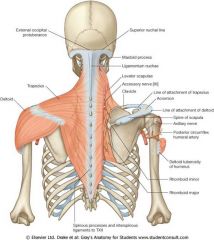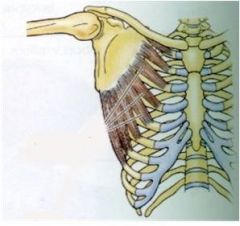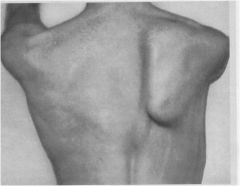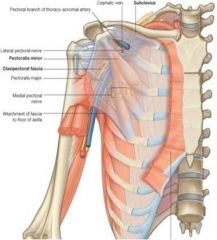![]()
![]()
![]()
Use LEFT and RIGHT arrow keys to navigate between flashcards;
Use UP and DOWN arrow keys to flip the card;
H to show hint;
A reads text to speech;
8 Cards in this Set
- Front
- Back
|
Name the joints of the pectoral girdle
|
1. Sternoclavicular
2. Acromioclavicular 3. Glenohumeral 4. Scapulocostal |
|
|
What are the 7 muscles that run from the trunk to the scapula (i.e. no involvement in the arm)?
|
1. Trapezius
2. Serratus anterior 3. Rhomboid major 4. Rhomboid minor 5. Levator scapulae 6. Pectoralis minor |
|
|
Describe the features of trapezius:
1. Origin 2. Insertion 3. Nerve supply 4. Action |

1. Origin:
- Occiput - Ligamentum nuchae - Vertebral spinous processes of C7 to T12 2. Insertion: - Spine of scapula - Acromion - Lateral third clavicle 3. Nerve Supply: Spinal Accessory Nerve CN X1 4. Actions: Elevation, retraction, depression, rotation of scapula (doesn't lift arm) |
|
|
Describe the features of serratus anterior:
1. Origin 2. Insertion 3. Nerve supply 4. Movement |

1. Origin:
Digitations from upper 8 ribs outer surface 2. Insertion: Costal surface medial border scapula 3. Nerve Supply: Long thoracic nerve of Bell C5 ,6 ,7 4. Actions: Protraction of scapula, upward rotation of lateral angle of scapula, holds scapula against chest |
|
|
What is winged scapula?
|

- Usually occurs on damage to the long thoracic nerve C5-7
- Serratus anterior no longer able to work, so scapula not held to thoracic wall - Patient unable to raise the upper limb fullly or to push with it |
|
|
Describe the features of rhomboid major and minor:
1. Origin 2. Insertion 3. Nerve supply 4. Movement |

1. Origin:
- Minor spinous processes C7 - T1 - Major spinous processes T2 - T5 2. Insertion: Medial border of scapula 3. Nerve Supply: Dorsal scapular nerve C4,5 4. Action: Retraction |
|
|
Describe the features of levator scapulae:
1. Origin 2. Insertion 3. Nerve supply 4. Movement |

1. Origin: Transverse processes C1 – C4
2. Insertion: Superior angle and upper medial border of scapula 3. Nerve Supply: Dorsal scapular nerve C5, small twigs from C3,4 4. Action: Elevation , rotation downwards of scapula |
|
|
Describe the features of pectoralis minor:
1. Origin 2. Insertion 3. Nerve supply 4. Movement |

1. Origin: Anterior aspect of 3rd – 5th ribs
2. Insertion: Coracoid process of scapula 3. Nerve Supply: Medial pectoral nerve C8,T1 4. Action: Protraction, depression, rotation (downwards) of scapula NB land mark muscle for the axillary artery |

